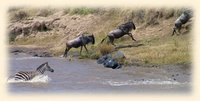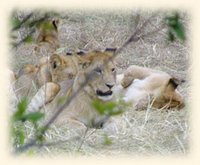Safari News
| Kenya newspapers, radio and media |
 The Great Wildebeest Migration Safari news update: September to October 2006 The Masai Mara is bristling with excitement: the final leg of the Great Migration has begun. For safari observers and wildlife photographers it is an astounding experience. But for tens of thousands of wildebeest, zebra and grazers, it is a time of trepidation. They eagerly anticipate the lush pasture which awaits them in the southern plains of the Serengeti, but their journey is fraught with danger at every turn. The tall grasslands conceal big hungry cats. Their cubs' pleading cries, coupled with the thundering sound of approaching hooves, is tantamount to ringing the dinner bell. Lions and cheetahs take up position, crouched low in the scrubland.
The Great Wildebeest Migration Safari news update: September to October 2006 The Masai Mara is bristling with excitement: the final leg of the Great Migration has begun. For safari observers and wildlife photographers it is an astounding experience. But for tens of thousands of wildebeest, zebra and grazers, it is a time of trepidation. They eagerly anticipate the lush pasture which awaits them in the southern plains of the Serengeti, but their journey is fraught with danger at every turn. The tall grasslands conceal big hungry cats. Their cubs' pleading cries, coupled with the thundering sound of approaching hooves, is tantamount to ringing the dinner bell. Lions and cheetahs take up position, crouched low in the scrubland. The Olkiombo pride of lions has been particularly active in the Olkinyei area of the central plains, while regular kills by the Ridge pride have also been reported.
The Olkiombo pride of lions has been particularly active in the Olkinyei area of the central plains, while regular kills by the Ridge pride have also been reported.
During the last fortnight, the quiet plains to the east of Lookout Hill have been unusually active. Many thousands of wildebeest have crossed the Mara River westwards into the Mara triangle. Though the still, murky waters of the Mara River offer a well-earned drink, even this simple pleasure can be treacherous: for lurking just beneath the surface are huge African crocodiles... with equally huge appetites. Some spectacular river crossings have been sighted - sometimes as early as 8am - as ferocious jaws lunge at the unsuspecting beasts and drag them under. With gazelles in abundance, cheetahs - especially mothers with hungry cubs to feed - have been very active of late.
With gazelles in abundance, cheetahs - especially mothers with hungry cubs to feed - have been very active of late.
Leopard sightings have also improved dramatically. The BBC's Big Cat Diary has helped track the movements of Bella and Chui. These two have offered the best leopard sightings in recent weeks. While the southern plains have become a hive of activity, a period of calm has descended upon the north of the Masai Mara National Reserve. The area around Musiara Marsh - teeming with wildebeest in August - has again fallen quiet. The northern part of the Masai Mara triangle is fairly inactive too, as most of the herds are congregating around Olpunyata Swamp and south of Kurao Plains. Grass is plentiful once again in the Masai Mara and wildebeest herds are expected to remain this side of the border at least until November.
The Cheetah Conservation Project Wildlife enthusiasts and conservationists will be relieved at the news that the Cheetah Census in Kenya research project has received funding to support cheetah population trend evaluations. Initiated in 2004, this project is a collaborative effort between the East African Wild Life Society (EAWLS), Cheetah Conservation Fund Kenya (CCFK) and the Kenya Wildlife Service (KWS). The project aims to gather information on the conservation status of the cheetah in Kenya. This information will then be used to make recommendations on future conservation and monitoring strategies for the Kenyan cheetah.
Floods in Kenya: November-December 2006
Severe flooding in Kenya's north eastern and coastal regions has taken at least 23 lives and displaced more than 80,000 people. Heavy rains are also expected in the western region. Up until recently, the region was suffering drought, but the welcome rains have been intense, leaving the hard, dry earth unable to absorb the heavy rains, causing flash floods. The worst affected area is around Garissa.
However, the floods have NOT affected any of the tourist circuits. The few disruptions that affected the Wasini and Shimoni-Kisite Island tours, have now been resolved. Shimba Hills is accessible though with some difficulty. There is concern for those travelling to Tanzania via the Lunga Lunga border and the majority of coastal tourist traffic is avoiding this route. Rains have worsened the condition of several roads, such as Malindi, but they are still accessible.
Kenya Drought Report: October 2006
The failure of anticipated rains between October and December 2005 resulted in crop failure, drought and depleted livestock herds. Particularly affected are the northern and eastern pastoral districts of Mandera, Wajir, and Marsabit. The drought has affected some 3.5 million people, but favourable rains are likely to alleviate the drought effects in coming months.
See Kenya climate and weather report.
Home | Climate | Travel preparations | Visa | Coast Province | Kenyan coast | Getting about | Beach accommodation | Diani Beach wildlife | Marine Parks | Life in Kenya | Maasai | Safaris | Safari news | Safari flight | Kenya safari wildlife | Game Reserves | Maps | Health | Safety | Wildlife webcam | Kenya Media |

<< Home